There are no more great adventures to be had. Been there, done that, seen it, ho hum …right?
Wrong.
There are still adventures to be had in this world, and I’ll tell you of several that happened in just a week.
Endeavour’s Final Voyage
First was the final trip taken by the Space Shuttle Endeavour, which lived up to its name. (You may not know: it was named after the British sailing ship HMS Endeavour, which took Captain James Cook on his first voyage of discovery to Australia and New Zealand from 1768 to 1771).
It was flown to Los Angeles International airport last month; here she is during that flight, off the southern California coast:
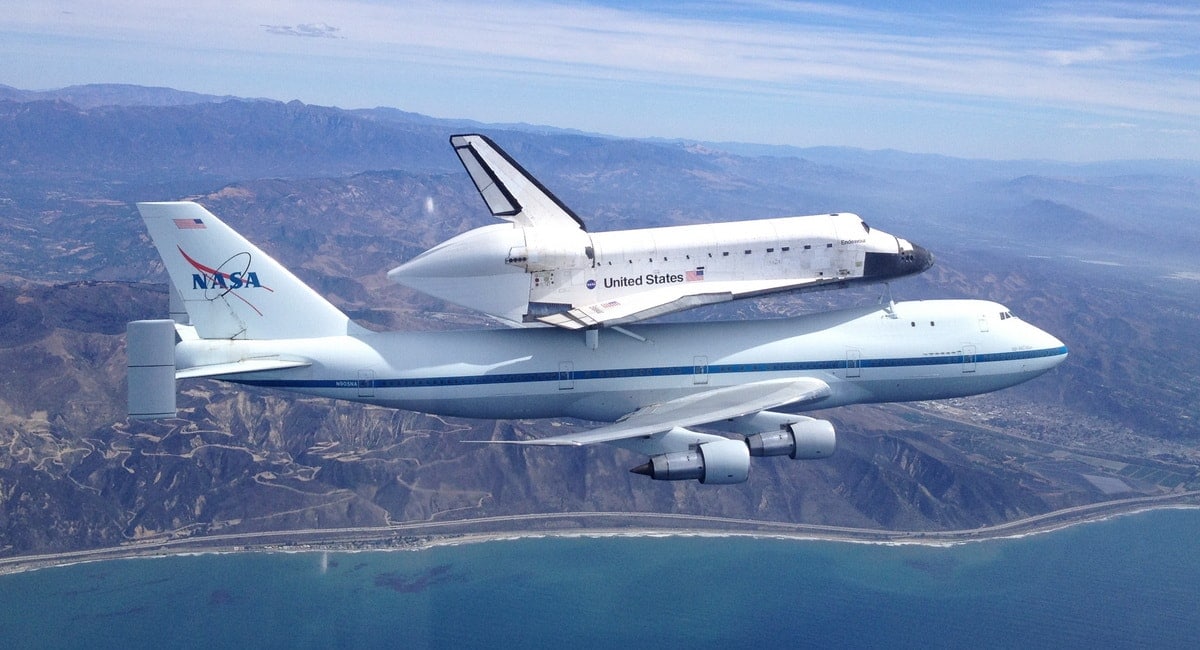
During that flight, thousands of people went outside to catch a glimpse, or take a photo, as it flew by. This past week it was taken, by road, to its final home, the California Science Center. And that part was also magic:
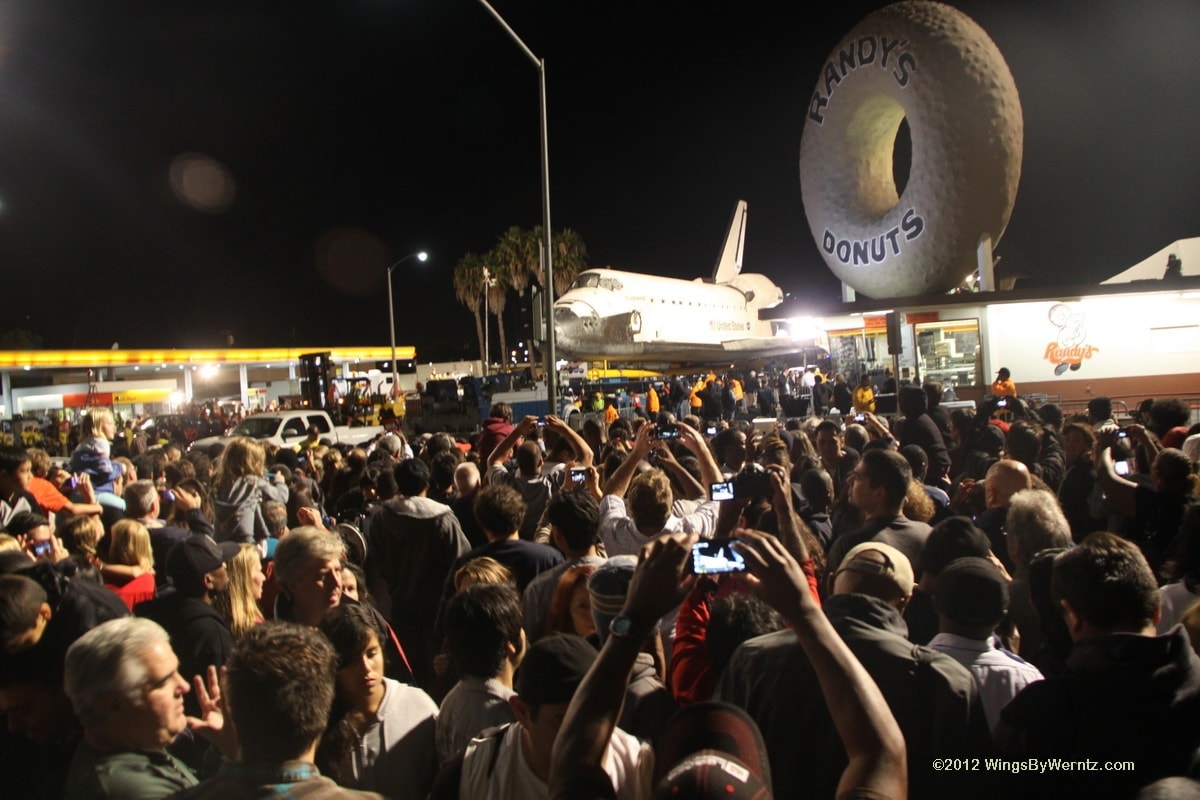
Thousands of Angelinos took to the streets just to watch, to be a part of the event: the retirement of a little-used spacecraft (it only had 122,883,151 miles, or 197,761,262 km, on its odometer, having flown in space for just 296 days, 3 hours, 34 minutes, 2 seconds over 25 missions — not that anyone’s counting).
Involving the Public
NASA was established by the National Aeronautics and Space Act, which was signed by President D.D. Eisenhower on July 29, 1958. The Space Act’s “Congressional Declaration of Policy and Purpose” notes right up front that “Congress declares that it is the policy of the United States that activities in space should be devoted to peaceful purposes for the benefit of all humankind.” As for Objectives, the very first was “The expansion of human knowledge of the Earth and of phenomena in the atmosphere and space.”
Expansion of human knowledge is number one. In the early days, NASA did a fantastic job of informing the public of what it was doing, the steps it was taking, to make progress.
We haven’t seen much of that lately. Indeed, NASA’s “educational outreach” activities have been continually squeezed. Who does a significant portion of such “outreach” now?
Volunteers. There isn’t much budget for staff jobs to actually educate the public about what’s going on, what’s being learned. Yet the public is starving for information, yearning to be a part of the NASA Mission. So much so, the entire route Endeavour took through L.A. was packed with people wanting to be a part of it. Day, night — it didn’t matter. People took time off work to go watch.
But wait: there’s more.
Item 2: Felix’s Jump
All of the mountains have been climbed. What adventurous thing is there left for an explorer to do anymore?
Felix Baumgartner thought of something to do, a record or three to break. On Sunday he flew in a helium balloon higher than any human had ever gone. It took him two and a half hours to get there.
And then he jumped out.
At 128,000+ feet above sea level, there’s practically no atmosphere; it’s truly the edge of space — more than 24 miles up. Baumgartner had to wear the equivalent of a space suit to be there. Here he is, at altitude, just after he opened the door to his capsule, dangling below a 55-storey balloon:
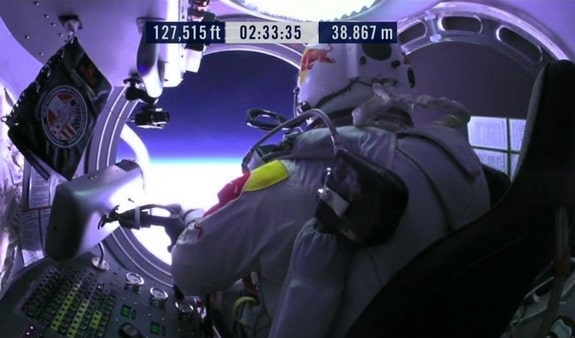
He then climbed out onto a tiny step…
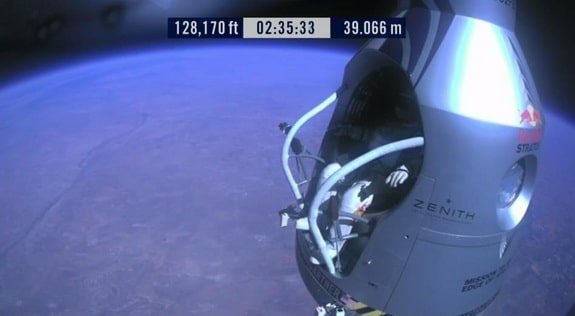
…and jumped:
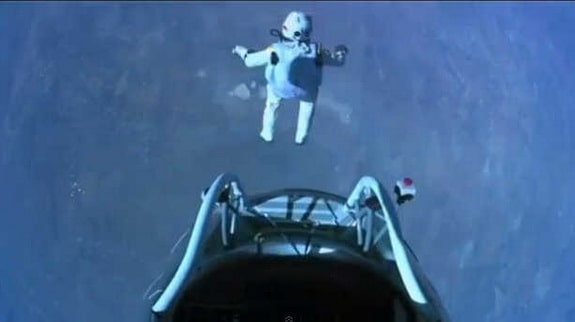
I was watching, live — and so were hundreds of thousands of others. He allowed only one voice on the radio in his ear to coordinate the event, to go through the checklist to give him the best possible odds to survive the feat: Joe Kittinger.
Who’s Joe Kittinger? He’s the guy who was the first to skydive from a balloon from above 100,000 ft — and he did it in 1960 (as part of a U.S. Air Force project, designed to test high-altitude parachutes).
Here’s Kittinger, as he jumped on August 16, 1960, from 102,800 feet (31,300 m).
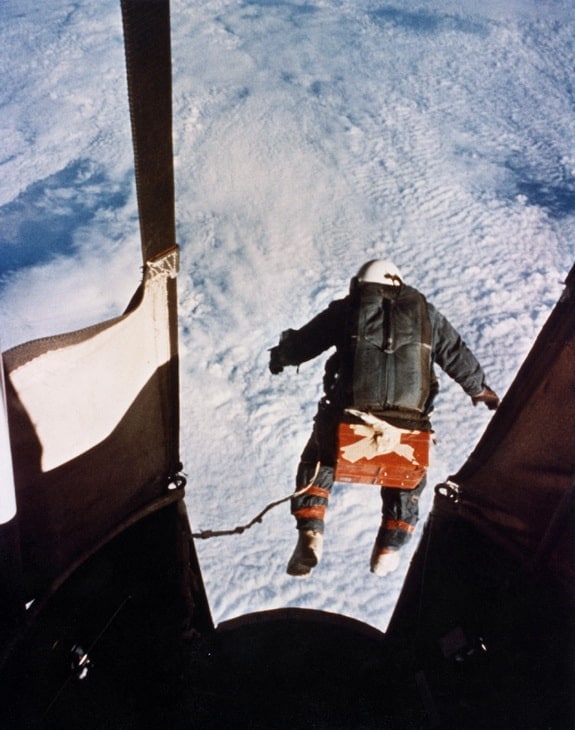
Kittinger’s record stood for more than 52 years — until he helped Baumgartner break it on Sunday. (At which time Kittinger was 84 years old. Yep: even “old guys” can still significantly contribute to adventures!)
Back in 1960, Kittinger towed a small drogue parachute for stabilization, so he “only” reached a maximum speed of 614 miles per hour (988 kph). He was in freefall for 4 minutes and 36 seconds before he opened his main parachute. Baumgartner didn’t use a drogue chute …and therefore went into a spin, causing him to almost black out. Just in time, he dropped low enough in the atmosphere for there to be atmosphere so he could get enough resistance to stabilize himself. But that enabled him to go faster: an estimated 834 mph (1,342 kph), making him the first human ever to break the sound barrier without the aid of a vehicle.
Now that’s an adventure! (But due to that increased speed, he missed breaking Kittinger’s freefall record — by just 17 seconds.)
Here’s the brief video recap, released shortly after the jump:
And a much more detailed video recap, which wasn’t released until January 2014 (added to this page 2 February 2014):
NASA, unfortunately, has been clueless about the accomplishment, which adds valuable new data they can benefit from. Someone at NASA tweeted congratulations (read: some low-level employee in public affairs responsible for the agency’s “social media” took it upon himself to do it).
NASA’s official web site? Totally silent more than 24 hours later.
That is, in part, why I so heartily support the transition from government-operated spacecraft. Transition to what?
The Transition to Commercial Space
Yep: private space vehicles. The Shuttle, magnificent as it was, was a horribly inefficient spacecraft. Each launch cost (when you included development and manufacturing costs) about $1.5 billion. President George W. Bush was right to cancel the Shuttle program, and President Barack Obama was right to affirm that cancellation and let it go out of business.
And there was a spectacular milestone on that front this past week too.
The concept of commercializing space isn’t anything new: it wasn’t Bush’s, nor Obama’s idea. It was part of the 1958 National Aeronautics and Space Act, which noted, “Congress declares that the general welfare of the United States requires that the Administration seek and encourage, to the maximum extent possible, the fullest commercial use of space.”
It’s about freaking time! It took more than 50 years to get there!
Private Sector Launch Platforms
Elon Musk, the guy who co-founded Paypal (and sold it to eBay for $1.5 billion) has put his estimated $2.4 billion net worth into something really visionary: he started a rocket company. In 2008, his newest company, SpaceX, was awarded a NASA contract for a dozen cargo flights to the Space Station. That didn’t cost NASA $18 billion, which is about what it would cost to do that with the Shuttle. No, the contract was “only” for $1.6 billion. A billion-five for a shuttle flight vs $133 million for a commercial rocket flight? As a taxpayer I’m all for it. “The Government” isn’t always known for making great decisions, but that was a great one.
SpaceX’s Dragon spacecraft did a “demonstration” flight to the Space Station in December, and it was a spectacular success. This weekend, the first “real” Dragon arrived at the Space Station with cargo. Yes, the United States is in the space launch business still, even without the Shuttle.
It flew up to the station atop the Falcon 9 rocket (which SpaceX also developed, privately). When it arrived…
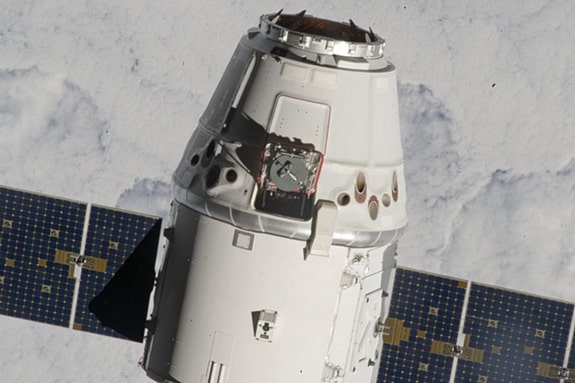
…Expedition 33 Commander Sunita Williams of the U.S. and flight engineer Aki Hoshide of Japan’s Aerospace Exploration Agency grabbed it with the Station’s robotic arm…

…and guided it to the docking port:
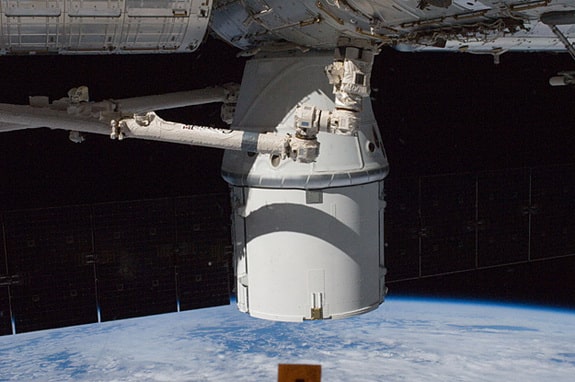
(Photos: NASA)
And that’s an adventure. Whether you love it because capitalism triumphed or because you just like that we’ve saved billions of dollars, which perhaps means we can do more science in space, doesn’t matter. It’s a terrific success.
Is this sort of spending “worth it”? It’s not just Tang, Velcro, and Teflon (none of which were actually created by, or even for, NASA!) A November 1971 study released by the Midwest Research Institute of Kansas City, Missouri, concluded that “the $25 billion in 1958 dollars spent on civilian space R&D during the 1958-1969 [Apollo moon program] period has returned $52 billion through 1971 — and will continue to produce pay offs through 1987, at which time the total pay off will have been $181 billion. The discounted rate of return for this investment will have been 33 percent.”
And I’ll bet that payback didn’t stop in 1987.
More recently, a 1992 article in the British science journal Nature reported that “The economic benefits of NASA’s programs are greater than generally realized. The main beneficiaries (the American public) may not even realize the source of their good fortune.” That was based on the 1989 Chapman Research report, which examined 259 non-space applications of NASA technology during an eight year period (1976–1984) and found more than:
- $21.6 billion in sales and benefits;
- 352,000 (mostly skilled) jobs created or saved, and;
- $355 million in federal corporate income taxes.
Here’s the kicker: those 259 applications, Nature noted, are “only 1% of an estimated 25,000 to 30,000 Space program spin-offs.”
And all that is before the commercial space sector was allowed to play. (SpaceX isn’t the only one, by the way. We’ll finally have redundancy for launches as another company gets its efforts online too.)
By the way: Elon Musk: South African. Felix Baumgartner: Austrian. Space isn’t just for Americans, not just for governments. Rather: “all humankind.”
So yeah: I think there’s a lot of adventure in our future: mind-blowing, thought-provoking, awe-inspiring achievement, and it won’t just be government employees doing it. That’s the best progress of all.
Been there, done that, seen it, ho hum? Not on your life. I can hardly wait for the next adventure. They’re out there, if you just apply just a little attention to watch for them. All that happened in the past week.
2022 Update
Joe Kittenger died on 9 December 2022 at 94. Even then, it took lung cancer to get him. He was one tough dude. More in his Honorary Unsubscribe.
– – –
Bad link? Broken image? Other problem on this page? Use the Help button lower right, and thanks.
This page is an example of my style of “Thought-Provoking Entertainment”. This is True is an email newsletter that uses “weird news” as a vehicle to explore the human condition in an entertaining way. If that sounds good, click here to open a subscribe form.
To really support This is True, you’re invited to sign up for a subscription to the much-expanded “Premium” edition:
Q: Why would I want to pay more than the minimum rate?
A: To support the publication to help it thrive and stay online: this kind of support means less future need for price increases (and smaller increases when they do happen), which enables more people to upgrade. This option was requested by existing Premium subscribers.

I was glued to Baumgartner’s jump, thanks to your tip (saw it on FB I think). Brought back boyhood memories of watching the moon landings — adrenaline pumping, hanging on every word of the announcer — hoping against hope they make it. What a thrill this was.
And thank you for the “adventure” perspective — good insight. (To quote the movie “UP!”: “Adventure is out there.” We just have to go get it.) I believe we’re in for some exciting times as 1) space goes commercial, 2) the internet/computers/phones mature, and 3) our species is forced to solve some enormous challenges over the next decades (and, yes, those three things are intimately related — “an exercise for the student” as my father-in-law, a professor, used to say).
—
It was fun to have a conversation on my Facebook page while it was going on. (I also put out a few tweets about it.) Glad quite a few readers were there to pick up on it; it was astounding to be able to watch it live. -rc
Here’s just one interesting NASA spinoff:
Originating in the designs and developments utilized in the thruster technology of the Saturn V rockets that have proven to be so successful in lifting payloads into space, civilian partners ORBITEC and their subsidiary HMA Fire have taken the lessons learned even farther.
The creation of UHP or Ultra High Pressure fire suppression systems has given demonstrated and proven capability of putting out fires faster and with less water. These systems not only knock out fires faster, but reduce temperatures and smoke production, making it safer for firefighters to aggressively do their jobs. Less water used means less damage, and extended fire fighting capabilities with the same water payload. One example is the UHP suppression system has repeatedly proven capability of extinguishing a fully engulfed car fire in 9 seconds.
HMA’s Hydrus systems are commercially available and being utilized both on their vehicle designs and skid-mounted to be placed on existing fire vehicles. They are seeing duty in Afghanistan at forward firebases and are present on many United States Army, Navy and Air Force bases here at home.
This design which began life lifting giant rockets into space, has now proven to be a lifesaver here on planet Earth, and is just one of hundreds of ways that space science benefits mankind.
Source: High Pressure Systems Suppress Fire in Seconds
NASA’s Spinoff Site has a lot more examples.
I have 2 questions about Felix’s jump — how much less is gravity at 120,000 ft.?
and
how did he take that second picture — where he is beginning to exit the capsule?
—
Hm. Well, 1) I have no idea, but he sure disappeared from view really quickly, and 2) There were a bunch of cameras inside and outside the capsule, all being streamed real-time back to Mission Control. As for your unasked question: 3) the capsule was cut loose from the balloon, and parachuted back to Earth. It landed not too long after he did. -rc
Wonderful stories! Just one little point: the captain of the original Endeavour was Lieutenant James Cook. A common mistake to confuse his rank and his position, even among Australians.
Re the gravity at 128,000 feet altitude: it is about 6% less than at the earth’s surface.
—
Thanks! A hardly noticeable difference. -rc
Great article!
If you didn’t watch this live streaming, you missed something. I don’t know how that guy fit into his suit with cajones that size.
Wow! So many things to respond to!
If the NAS Act wanted commercialization of space, why was Ford kicked out of the space biz when they tried to enter it?
As far as the Chapman report’s “$355 million in federal corporate income taxes” goes, yes, I believe that. However, if that were to happen now that “corporations are people”, how much would those taxes have benefited the country?
Won’t the tendency of UHP fire suppression to violently kick around whatever is INSIDE whatever is on fire kinda tend to do as much damage as the actual water?
Captain James Cook: “Captain” is a position as well as a rank. When in command of H.M.S. Endeavour, Cook was addressed by his position.
I thought the 6% number sounded a bit off, so I dusted off my inverse square law and the Google calculator and indeed it looks like it’s just a touch over 1%.
The 6% number is for an orbit about 200km up, which is about the lowest you can go without rapidly losing speed due to atmosphere. The space station is at closer to 300km, more like 9% weaker.
There were a couple of inaccuracies:
1. There were actually millions of people watching the jump online: http://youtube-global.blogspot.com/2012/10/mission-complete-red-bull-stratos-lands.html
2. Nature is not a British journal.
—
1) Glad to see a number (the referenced page notes there were “more than 8 million concurrent livestreams” at the peak). 2) Nature was founded at the Imperial College London in 1869. It is edited and published in the United Kingdom by Nature Publishing Group, a subsidiary of Macmillan Publishers (as your link notes), which in turn is owned by the Georg von Holtzbrinck Publishing Group. I’m comfortable with calling it a “British” publication, vs American or German. -rc
I could help but notice in the second photo you’re advertising your new business. Just the perfect sort of business for an ex-cop or EMT to operate.
Do you do a special deal on the jelly filled donuts for the shift sergeant?
On subject — it’s a shame NASA doesn’t seem interested in doing more on the Moon, like say a permanent base or colony.
—
Once I saw the name of the business (not to mention the oh-so-L.A. giant sign!), I had to use that photo; it was just too perfect. NASA is definitely “interested” in a permanent moon base, but the holders of the purse strings (the elected officials) have not provided funding for such a mission. -rc
Well, to respond to “So many things to respond to!”….
When I was at Mission Control in 1982, the private company contracted to operate it was Rockwell International. I believe Ford held the contract previously to that. I’m certain another company took the contract after Rockwell. Always a matter of bidding on the contract, not who was “kicked out.”
Corporations have always been “people,” or more specifically, “artificial entities,” going back the entire history of the U.S. and even long before in England. In the U.S., that’s why they CAN be taxed and, subsequently, “represented.”
But you ARE right in that even non-commissioned enlisted man is still “Captain” if he is the highest ranking leader on board a ship. But ONLY during that command. That’s also why many “Generals” during a war revert back to a lower officer’s rank when the war ends.
Unrelated, those who believe there are no more adventures remind me of the statement supposedly made by the London Science Society in 1899 that “Anything of importance has already been discovered.”
Responding to Mike from Dallas:
I actually believe I remember hearing that Ford was attempting to go to into space on their own dime, but were told by the US government not to do so.
The more recent “a corporation is a person” legality (as I understand it) is what has enabled corporations to pay so little in taxes in recent years.
While Felix’s jump was significant, here are valid criticisms of it.
It’s not so much that it shouldn’t have been done as it is a wasted opportunity to really educate people.
One of the worst of mistaken impressions left by the video is that 8 million+ people think 24 miles up is ‘space’. The agreed upon demarcation for space is about 62 miles.
—
Could Redbull have done better to educate the audience that tuned in? You bet! Could NASA? You bet! Could the public school system? —Well, you get the idea. I reject the thought that if it isn’t done perfectly, it’s not worth doing.
As for your second part, Redbull used the phrase “edge of space” in its promotions. The demarcation for what constitutes “space” varies depending on who you talk to. The Fédération Aéronautique Internationale Sporting Code is where your 62-mile figure comes in, since that’s a nice round 100 kilometers. In the United States, professional, military, and commercial astronauts who travel above an altitude of 50 miles (80 km) are awarded astronaut wings. Both are arbitrary, but I agree Felix indeed got less than half-way there. Yet even if they baldly said “space”, just because 8 million heard it doesn’t mean they “think” that’s true. -rc
I believe the quote offered by Mike from Dallas could be:
“Everything that can be invented has been invented.”
—Charles H. Duell, Commissioner, U.S. patent office, 1899
—
There are many such quotes:
And there are many more. -rc
“The concept of commercializing space isn’t anything new: it wasn’t Bush’s, nor Obama’s idea. It was part of the 1958 National Aeronautics and Space Act….”
I like to think that someone behind that legislation was familiar with science-fiction writer Robert Heinlein. He wrote two novels — one in 1940, another in 1955 — about a man named D.D. Harriman. He was, as one of the titles put it, The Man Who Sold the Moon.
Harriman is “the last of the robber barons” who “spends much of his career and resources making space flight a practical commercial enterprise” (Wikipedia). By hook and by crook, he ends up instigating a ‘gold rush’ to the moon of privately-built spacecraft in search of rumored mineral riches.
Wouldn’t that be something to see?
—
I wouldn’t be surprised to see it. Heinlein (as well as Isaac Asimov and Arthur C. Clarke, especially) had massive influence on the people who worked at NASA. But I have no idea how deep it went “officially”.-rc
I was at New Mexico Tech (Socorro, NM) at a kickoff for the NM Supercomputer Competition when Felix stepped out. There were a few hundred high school students and 60+ adults. The air pressure DECREASED from everybody breathing in (gasp) all at once. Very visceral experience.
It was one of those “I will remember until I die” moments.
Also cool the launch and landing were both in New Mexico.
I happened to see the last flight of the the Space Shuttle Endeavour; I was in the Bay Area, driving to work. I was in a deep valley in the Hayward area when I heard a loud aircraft noise. I looked up and saw the 747 with Endeavor on top fly over. Right time and place.
I have wanted off this rock since I was 7 (Mike MARS books, Heinlein juveniles, etc). Now 65, so the only chance is my ashes making orbit or the Moon. I saw several Gemini and Apollo launches on an old B&W TV. I listened to the Apollo 7 broadcast of Genesis as they circled the Moon. We bought a TV for Apollo 11….
NASA picked those who truly had the “Right Stuff” — including the engineers, techs, and flight crews. Apollo 13 is a shining example. (Another was Apollo 10. They came within literal seconds of cratering into the Moon before they were able to fix the problem.)
I am glad the private launch services are finally here. It took people with the resources of a nation state to make it possible. Space Tourism is finally in the demo phase, with more to come.
Ad Astra!
Small correction–The Genesis readings were from Apollo 8, which circumnavigated the Moon and returned. Apollo 7 “only” went into Earth orbit.
Thanks! I knew that, but didn’t proof read 🙁
My grandmother was born in 1899 and remembered the first time she saw an airplane. She died in 2002, and we talked so many times about the miracles of the Century, including space flight and a man walking on the moon.
Yes, we have become used to it, and NASA gave way to big business. I remember the awe when I saw a video of a SpaceX rocket landing for the first time. Now I gotta call Virgin Galactic and book a flight.
Living is the adventure, Randy!!! My first internet site each morning is NASA’s APOD to see what’s new out there. Btw even in the updates you’ve neglected to remind us that the Roboarm is the CanadArm !~ but that aside, thanks for sharing your own adventures and others.
—
APOD is awesome. I don’t name the station modules, either. Those who know, know, and it could be confusing for those who don’t. I wanted to leave folks feeling wonder, not confusion. No slight to our neighbors intended! -rc
Kudos to Baumgartner and Red Bull. But 2 years later, Alan Eustace beat his record:
“On October 24, 2014, Eustace made a jump from the stratosphere, breaking Felix Baumgartner’s 2012 world record.”
—
Indeed all such records are destined to fall eventually, so thanks for making note. Kittinger still holds one record: longest-duration free fall, at 4 minutes and 36 seconds, during his 1960 jump from 102,800 feet (31.3 km). -rc
I was in a large room the Sunday morning for the kickoff of the New Mexico Supercomputer Challenge. It was at New Mexico Tech (NMT), my alma mater. We had met with the student groups and had a buffet lunch. There were roughly 225-250 people in the room. The large video screen showed Felix getting ready. When he stepped out, everybody sucked in air (ooohhh) at the same time. The room pressure dropped notably. It was a unique visceral experience.
(Normally, that time is a talk by a scientist on their subject. The contest gets some heavy hitters. One year at the first weekend, it was the Principal Investigator for the Mars ChemBot.)
It’s a really cool program. It is old enough that kids of the first batches are now competing. A team is 2-5, from the same school. They figure out what they want to do — the subject, then how to do it.. One of the reasons for the first weekend is help the teams figure out their project, sources for experts, and resources.
The team then creates a computer model. The team can use any appropriate tool/language. They are encouraged to contact experts in their project subjects. Finally, they prepare a report and send it in.
Some teams don’t know what they want to do. We “visiting scientists” use questions to guide the team to decide on a topic. The idea must be from the team, so we ask leading questions, like “What are you interested in?”, then name several topic areas. Some teams have already figured out what they wanted to do, but lacked resources.
For example, a team was from a reservation on the New Mexico and Colorado border. The EPA busted in the CO mine and spilled heavy metal into a river, which went through the reservation. They wanted to model the deposition of the heavy metals over time and travel. We were able to direct them to geologists and hydrologists at University of New Mexico (UNM) and the USGS. We assured them that the scientists would be excited to answer their questions. “Dear, some students called up with questions for a science project!!”. It would make their year.
The organizers and other Subject Matter Experts judge the reports and award prizes. All teams come to the award ceremony on the second weekend, where the prizes are awarded. No matter what, these kids are really excited about STEM.
All of this is paid for by donations and grants from companies, non-profits, NM colleges, and the LANL and SNL national labs, The first weekend is at New Mexico Tech (NMT). Saturday has classes during the day, then a pizza dinner and a lecture by a leading scientist. There is enough for hotel rooms, some on Friday, all Saturday night. Meals are at the NMT cafeteria (which was better than when I was a student :^).
NMT in Socorro is a fantastic engineering college. You need to be able to live in a small town (roughly 12K) in the middle of nowhere (75 miles north or south) to the next real town. Currently, roughly 1700 students. Some folks just need bigger cities. Top education by top instructors. Also home to EMRTC — Energetic Materials Research Test Center. Mythbusters used it for some episodes, and promoted it.
It is the home of the Very Large Array (VLA) headquarters. The VLA scopes are about an hour west. Worth the trip, It was used in the movies Contact and 2010. Mind the speed limit going through the small towns. Easy money for the town… Call for any tours, usually Saturday morning.
The name is because the student models required so much compute power, it took the NM supercomputer (SC) to run in a reasonable time. How times have changed. Now a reasonable tower and a mid-range Nvidia makes the supercomputer look like an old cripple gimping along. At some small fraction of the power and orders of magnitude for the compute power. The SC was retired and the boards were distributed.
—
I love it that the Challenge continues; this year’s is complete.
My old EMS boss offered to send me to NYT’s explosives class for first responders so there would be someone with that knowledge on the team. I decided not to burn that tax money, even though it would have been awesome. I’ll leave that to a younger first responder. -rc